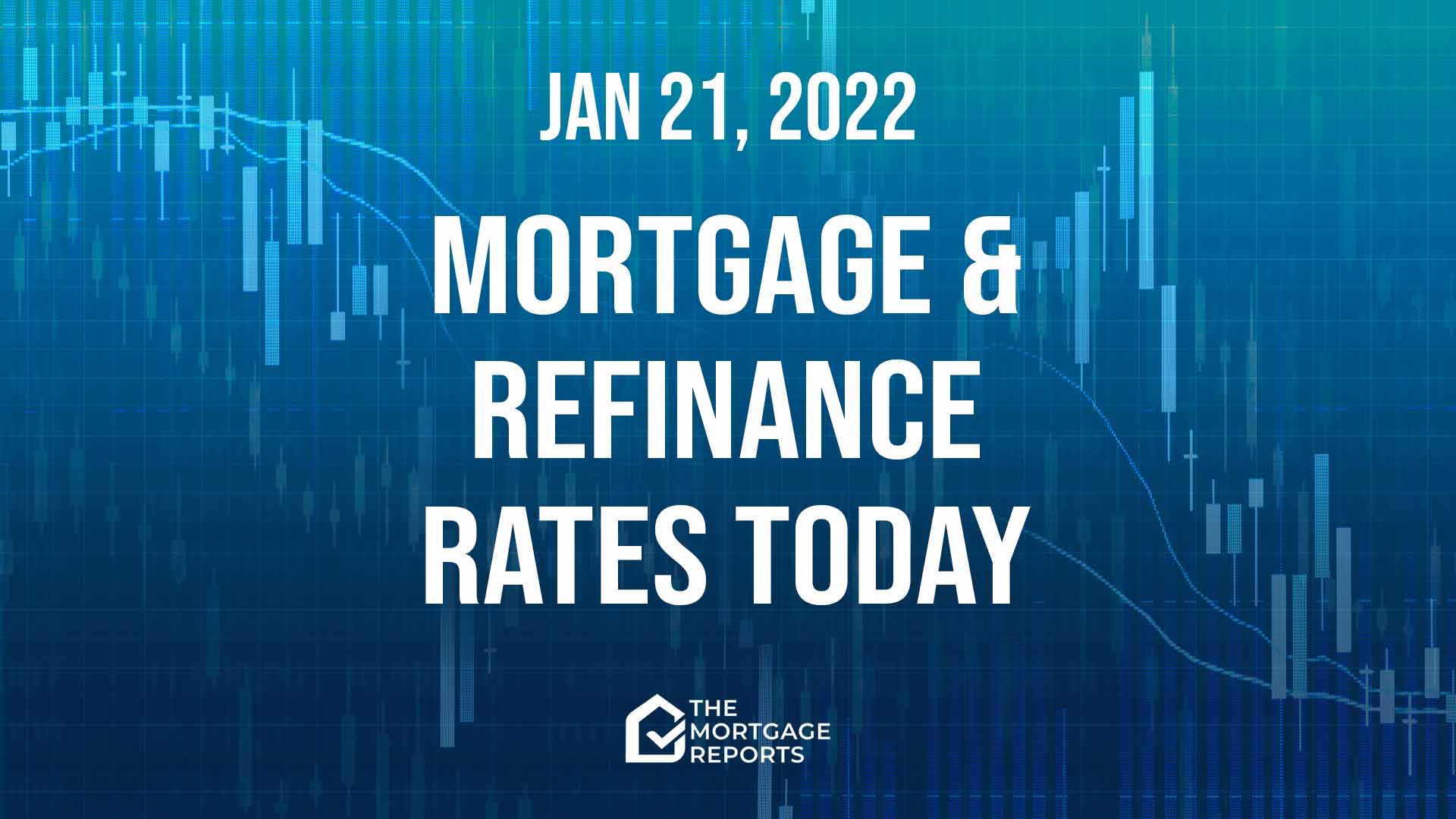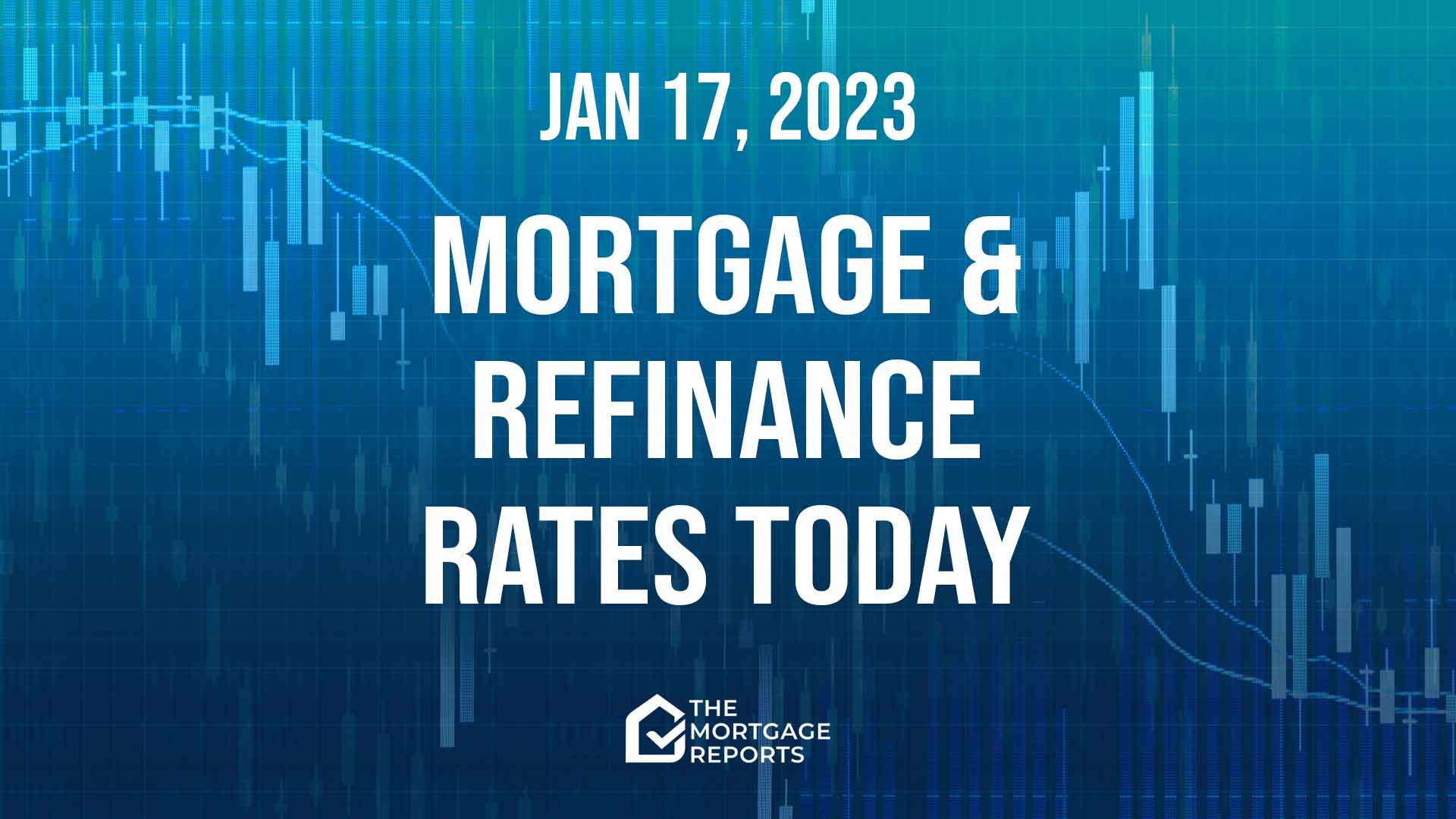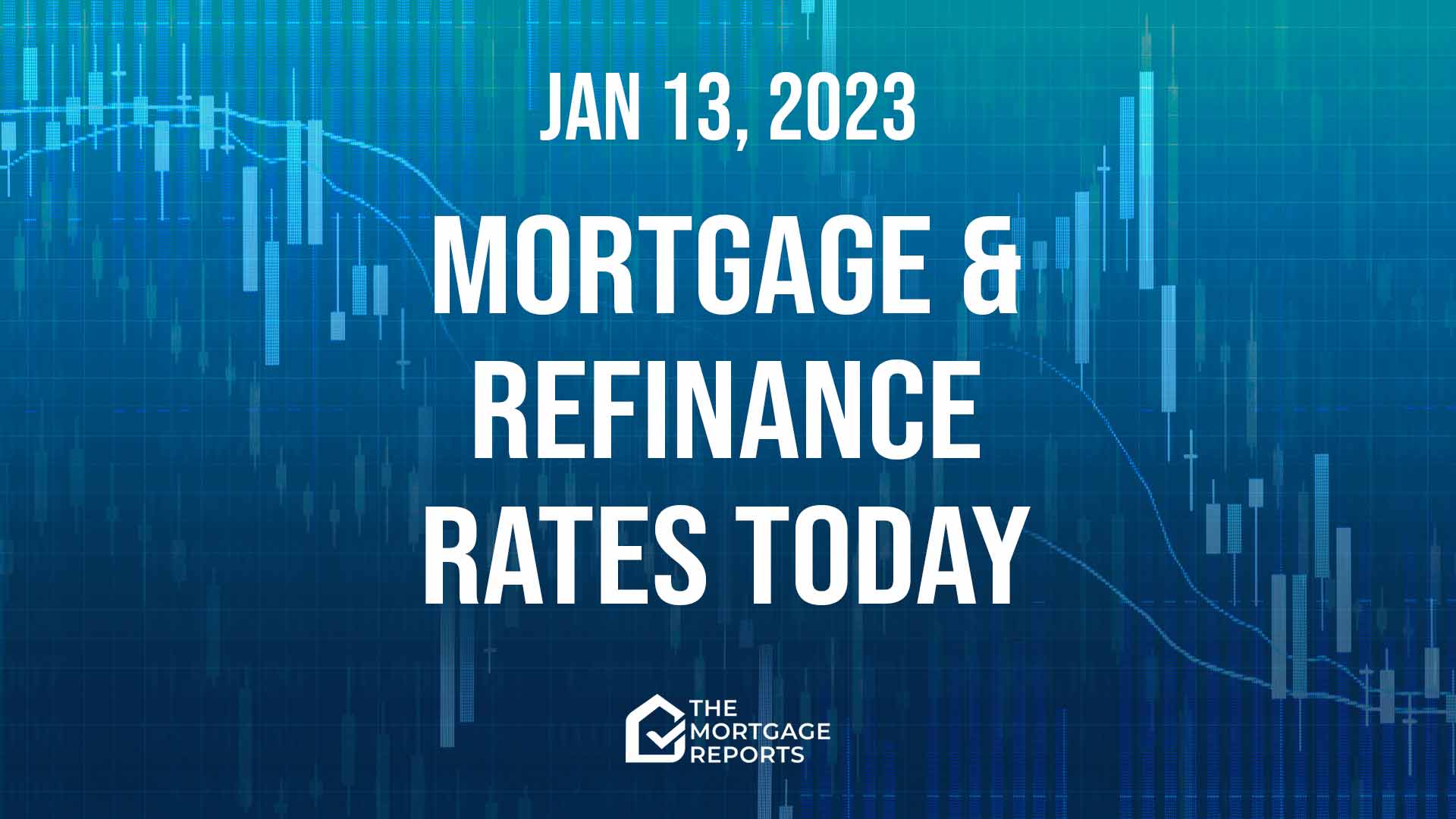
Today’s mortgage and refinance rates
Average mortgage rates inched lower yesterday but only by the smallest measurable amount. Of course, those rates are high by recent standards. But they remain very low by historical ones.
It’s looking as if mortgage rates today might fall again, probably moderately. That’s because investors are looking forward to a key Federal Reserve meeting next week. But, as always, markets may change as the day progresses.
Find your lowest rate. Start here (Jan 21st, 2022)Current mortgage and refinance rates
| Program | Mortgage Rate | APR* | Change |
|---|---|---|---|
| Conventional 30 year fixed | |||
| Conventional 30 year fixed | 3.789% | 3.812% | -0.05% |
| Conventional 15 year fixed | |||
| Conventional 15 year fixed | 3.137% | 3.174% | +0.01% |
| Conventional 20 year fixed | |||
| Conventional 20 year fixed | 3.52% | 3.558% | -0.05% |
| Conventional 10 year fixed | |||
| Conventional 10 year fixed | 3.047% | 3.115% | -0.03% |
| 30 year fixed FHA | |||
| 30 year fixed FHA | 3.856% | 4.633% | -0.04% |
| 15 year fixed FHA | |||
| 15 year fixed FHA | 3.132% | 3.784% | -0.01% |
| 5/1 ARM FHA | |||
| 5/1 ARM FHA | 3.652% | 3.973% | -0.01% |
| 30 year fixed VA | |||
| 30 year fixed VA | 3.889% | 4.096% | -0.02% |
| 15 year fixed VA | |||
| 15 year fixed VA | 3.282% | 3.623% | Unchanged |
| 5/1 ARM VA | |||
| 5/1 ARM VA | 3.189% | 2.967% | Unchanged |
| Rates are provided by our partner network, and may not reflect the market. Your rate might be different. Click here for a personalized rate quote. See our rate assumptions here. | |||
Should you lock a mortgage rate today?
The last couple of days came as a relief after a period of relentless rises in mortgage rates. With luck, we might see a moderate fall today.
But you should probably assume that those rates are currently on a plateau. And that they still have further to climb — though, we hope, less steeply than before.
That sums up what I’m expecting. Of course, I may be proved wrong. But it would probably take a major event to send them falling in a sustained way. So, for now, my personal rate lock recommendations remain:
- LOCK if closing in 7 days
- LOCK if closing in 15 days
- LOCK if closing in 30 days
- LOCK if closing in 45 days
- LOCK if closing in 60 days
>Related: 7 Tips to get the best refinance rate
Market data affecting today’s mortgage rates
Here’s a snapshot of the state of play this morning at about 9:50 a.m. (ET). The data, compared with roughly the same time yesterday, were:
- The yield on 10-year Treasury notes fell to 1.76% from 1.83%. (Good for mortgage rates.) More than any other market, mortgage rates normally tend to follow these particular Treasury bond yields
- Major stock indexes were mostly lower. (Good for mortgage rates.) When investors are buying shares they’re often selling bonds, which pushes prices of those down and increases yields and mortgage rates. The opposite may happen when indexes are lower. But this is an imperfect relationship
- Oil prices decreased to $84.69 from $86.71 a barrel. (Good for mortgage rates*.) Energy prices play a large role in creating inflation and also point to future economic activity
- Gold prices edged down to $1,842 from $1,846 an ounce. (Neutral for mortgage rates*.) In general, it is better for rates when gold rises, and worse when gold falls. Gold tends to rise when investors worry about the economy. And worried investors tend to push rates lower
- CNN Business Fear & Greed index — dropped to 48 from 57 out of 100. (Good for mortgage rates.) “Greedy” investors push bond prices down (and interest rates up) as they leave the bond market and move into stocks, while “fearful” investors do the opposite. So lower readings are better than higher ones
Caveats about markets and rates
Before the pandemic and the Federal Reserve’s interventions in the mortgage market, you could look at the above figures and make a pretty good guess about what would happen to mortgage rates that day. But that’s no longer the case. We still make daily calls. And are usually right. But our record for accuracy won’t achieve its former high levels until things settle down.
So use markets only as a rough guide. Because they have to be exceptionally strong or weak to rely on them. But, with that caveat, mortgage rates today are likely to fall. However, be aware that “intraday swings” (when rates change direction during the day) are a common feature right now.
Find your lowest rate. Start here (Jan 21st, 2022)Important notes on today’s mortgage rates
Here are some things you need to know:
- Typically, mortgage rates go up when the economy’s doing well and down when it’s in trouble. But there are exceptions. Read ‘How mortgage rates are determined and why you should care‘
- Only “top-tier” borrowers (with stellar credit scores, big down payments and very healthy finances) get the ultralow mortgage rates you’ll see advertised
- Lenders vary. Yours may or may not follow the crowd when it comes to daily rate movements — though they all usually follow the wider trend over time
- When daily rate changes are small, some lenders will adjust closing costs and leave their rate cards the same
- Refinance rates are typically close to those for purchases.
A lot is going on at the moment. And nobody can claim to know with certainty what’s going to happen to mortgage rates in coming hours, days, weeks or months.
Are mortgage and refinance rates rising or falling?
Rises over the last 30 days or so have finally moderated. But rates still look likely to end this week higher than they did last.
And the drivers of recent rises remain potent:
- The Federal Reserve’s early dismantling of its pandemic-era stimulus programs. Expect more news on this next Wednesday afternoon (Jan. 26) following the upcoming meeting of its monetary policy committee
- Uncomfortably high inflation
- Optimism over the COVID-19 pandemic
- A continuing, strong — if patchy — economic recovery
Each of those puts upward pressure on mortgage rates. And there’s little sign of any of them changing. That’s why I’m reasonably confident that those rates will climb higher, though probably more slowly than of late.
But the future’s never certain. And it’s always possible than some earth-shattering event will come along that changes everything. Let’s hope that remains unlikely.
For a longer overview of what’s driving mortgage rates, including why markets are optimistic about Omicron, read the weekend edition of this daily rates report.
Recently
Over much of 2020, the overall trend for mortgage rates was clearly downward. And a new, weekly all-time low was set on 16 occasions last year, according to Freddie Mac.
The most recent weekly record low occurred on Jan. 7, when it stood at 2.65% for 30-year fixed-rate mortgages.
Since then, the picture has been mixed with extended periods of rises and falls. Unfortunately, since September, the rises have grown more pronounced, though not consistently so.
Freddie’s Jan. 20 report puts that weekly average for 30-year, fixed-rate mortgages at 3.56% (with 0.7 fees and points), up from the previous week’s 3.45%.
Expert mortgage rate forecasts
Looking further ahead, Fannie Mae, Freddie Mac and the Mortgage Bankers Association (MBA) each has a team of economists dedicated to monitoring and forecasting what will happen to the economy, the housing sector and mortgage rates.
And here are their current rate forecasts for the remaining, current quarter of 2021 (Q4/21) and the first three quarters of 2022 (Q1/22, Q2/22 and Q3/22).
The numbers in the table below are for 30-year, fixed-rate mortgages. Fannie’s were published on Jan. 19 and the MBA’s on Dec. 21.
Freddie’s were released on Oct. 15. It now updates its forecasts only quarterly. So we may not get another from it until later this month. And its figures are already looking stale.
| Forecaster | Q4/21 | Q1/22 | Q2/22 | Q3/22 |
| Fannie Mae | 3.1% | 3.2% | 3.3% | 3.3% |
| Freddie Mac | 3.2% | 3.4% | 3.5% | 3.6% |
| MBA | 3.1% | 3.3% | 3.5% | 3.7% |
Personally, I was surprised that Fannie Mae only slightly increased its rate forecasts in January. It believes that rates for 30-year, fixed-rate mortgages will average 3.2% in the current quarter. But, on the day its figures were published, we reported they were already up to 3.87%.
Do Fannie’s economists expect those rates to plummet in February or March and remain lower in the following quarters? If so, they know something that I don’t.
Of course, given so many unknowables, the whole current crop of forecasts may be even more speculative than usual.
Find your lowest rate today
You should comparison shop widely, no matter what sort of mortgage you want. As federal regulator the Consumer Financial Protection Bureau says:
“Shopping around for your mortgage has the potential to lead to real savings. It may not sound like much, but saving even a quarter of a point in interest on your mortgage saves you thousands of dollars over the life of your loan.”
Verify your new rate (Jan 21st, 2022)Mortgage rate methodology




